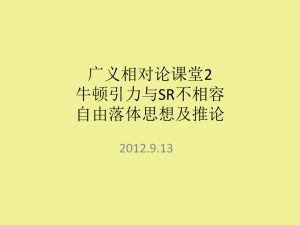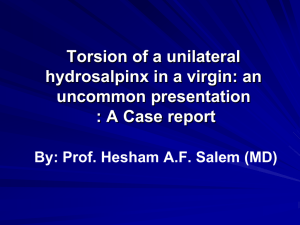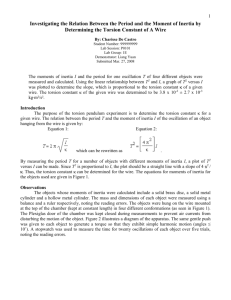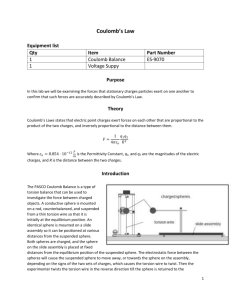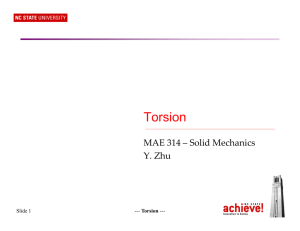gravitation
advertisement
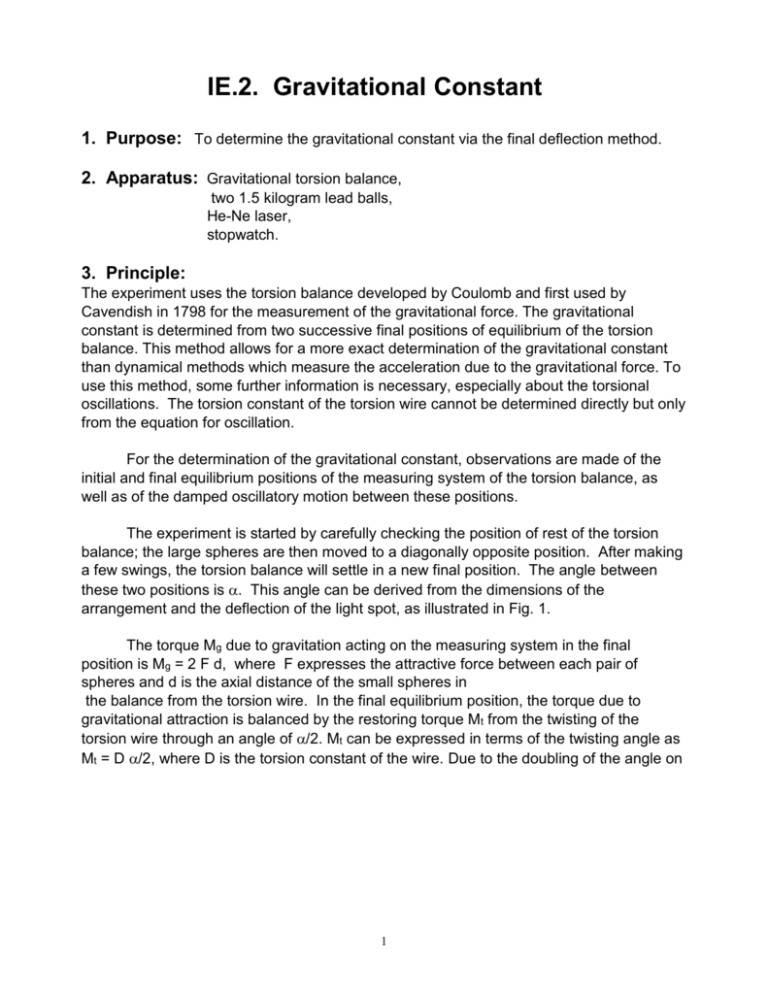
IE.2. Gravitational Constant 1. Purpose: To determine the gravitational constant via the final deflection method. 2. Apparatus: Gravitational torsion balance, two 1.5 kilogram lead balls, He-Ne laser, stopwatch. 3. Principle: The experiment uses the torsion balance developed by Coulomb and first used by Cavendish in 1798 for the measurement of the gravitational force. The gravitational constant is determined from two successive final positions of equilibrium of the torsion balance. This method allows for a more exact determination of the gravitational constant than dynamical methods which measure the acceleration due to the gravitational force. To use this method, some further information is necessary, especially about the torsional oscillations. The torsion constant of the torsion wire cannot be determined directly but only from the equation for oscillation. For the determination of the gravitational constant, observations are made of the initial and final equilibrium positions of the measuring system of the torsion balance, as well as of the damped oscillatory motion between these positions. The experiment is started by carefully checking the position of rest of the torsion balance; the large spheres are then moved to a diagonally opposite position. After making a few swings, the torsion balance will settle in a new final position. The angle between these two positions is . This angle can be derived from the dimensions of the arrangement and the deflection of the light spot, as illustrated in Fig. 1. The torque Mg due to gravitation acting on the measuring system in the final position is Mg = 2 F d, where F expresses the attractive force between each pair of spheres and d is the axial distance of the small spheres in the balance from the torsion wire. In the final equilibrium position, the torque due to gravitational attraction is balanced by the restoring torque Mt from the twisting of the torsion wire through an angle of /2. Mt can be expressed in terms of the twisting angle as Mt = D /2, where D is the torsion constant of the wire. Due to the doubling of the angle on 1 reflection n, S/L = tan 2, s/d = tan 1), where s = path of the small spheres in the balance, d = distance of the small spheres from the axis, S = path of the light spot on the wall, L = distance of the wall from the mirror of the balance (see Fig. 1) The torsion constant D can be derived from the period of torsional oscillation T of the torsion pendulum: T2 = 42 I/D (2) or D = 42I/T2 The moment of inertia I appearing here can be approximated by the moment of inertia of the two small spheres I = 2m2d2 because the suspension with the mirror gives only a negligible contribution to the moment of inertia; therefore D = 82m2d2/T2 (3) In the final equilibrium position, Mt = Mg ; using Mg = 2Fd = 2Gm1m2d/b2 and Mt = D /2, with D as obtained from above, one gets 4Gm1m2/b2 = (82dm2/T2) S/(2L) (4) From this one obtains G = 2b2dS/(m1T2L) (5) This formula for the gravitational constant contains only measurable quantities. The mass of the small sphere does not appear in the result, so that knowledge of it is not necessary. 2 4. Useful hints: 4.1. For the operation and adjustment of the gravitation torsion balance, see your instructor. 4.2. Before beginning the measurements, the zero point must be observed for several minutes. 4.3. The displacing of the spheres must be done carefully. The spheres should be prevented from knocking against the glass window of the apparatus. 4.4. After displacing the spheres the position of the laser spot must be recorded often, at least once every ½ minute. Try to also catch the points corresponding to maximum elongation and record their time. The period of oscillation can be determined from plotting the graph of position (elongation) vs. time. Since the square of this period appears in the result, the average of several values must be taken. 4.5. After the experiment, the final position should be observed for some minutes and recorded. In this way a possible backlash of the zero point of the balance can be taken into account. 4.6. Example Numerical values from manufacturer: b = 0.0456m 3 d = 0.05 m m1 = 1.50 kg 4.7. The value determined is subject to the following systematic error: The small sphere will also be attracted by the more distant second large sphere with a very much smaller force F'o (see Fig. 3) This force is given by the gravitational law F'o = 2G m2m1/(b2 +4d2) (4) and has a component f opposite to that of the force Fo (which is to be measured). f = 2G m2m1/(b2 + 4d2) b/(b2 + 4d2) = Fo (5) where = b3/[(b2 + 4d2) (b2 + 4d2)] (6) The value of G found without this correction must be increased by a factor (1 + ) 4
